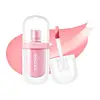What's inside
What's inside
 Key Ingredients
Key Ingredients

 Benefits
Benefits

 Concerns
Concerns

 Ingredients Side-by-side
Ingredients Side-by-side

Water
Skin ConditioningDiphenyl Dimethicone
EmollientDiisostearyl Malate
EmollientBis-Diglyceryl Polyacyladipate-2
EmollientHydrogenated Polyisobutene
EmollientBis-Behenyl/Isostearyl/Phytosteryl Dimer Dilinoleyl Dimer Dilinoleate
EmollientCetyl PEG/PPG-10/1 Dimethicone
EmulsifyingDiglycerin
HumectantHydrogenated Polydecene
EmollientDipropylene Glycol
HumectantPolysorbate 60
EmulsifyingSorbitan Isostearate
EmulsifyingHydroxyethyl Acrylate/Sodium Acryloyldimethyl Taurate Copolymer
Emulsion StabilisingPentylene Glycol
Skin ConditioningSqualane
EmollientTitanium Dioxide
Cosmetic ColorantEthylene/Propylene Copolymer
AbrasiveCeteareth-20
CleansingPhenoxyethanol
PreservativePolyglycerin-3
HumectantCI 19140
Cosmetic ColorantAcid Red 33
Parfum
MaskingEthylhexylglycerin
Skin ConditioningGlycerin
HumectantAluminum Hydroxide
EmollientAmmonium Polyacrylate
StabilisingCI 15985
Cosmetic ColorantButylene Glycol
HumectantCI 42090
Cosmetic ColorantTocopheryl Acetate
AntioxidantPrunus Persica Fruit Extract
Abrasive1,2-Hexanediol
Skin ConditioningSodium Hyaluronate
HumectantHydroxypropyltrimonium Hyaluronate
Sodium Acetylated Hyaluronate
HumectantHydrolyzed Hyaluronic Acid
HumectantHyaluronic Acid
HumectantSodium Hyaluronate Crosspolymer
HumectantHydrolyzed Sodium Hyaluronate
Skin ConditioningPotassium Hyaluronate
Skin ConditioningWater, Diphenyl Dimethicone, Diisostearyl Malate, Bis-Diglyceryl Polyacyladipate-2, Hydrogenated Polyisobutene, Bis-Behenyl/Isostearyl/Phytosteryl Dimer Dilinoleyl Dimer Dilinoleate, Cetyl PEG/PPG-10/1 Dimethicone, Diglycerin, Hydrogenated Polydecene, Dipropylene Glycol, Polysorbate 60, Sorbitan Isostearate, Hydroxyethyl Acrylate/Sodium Acryloyldimethyl Taurate Copolymer, Pentylene Glycol, Squalane, Titanium Dioxide, Ethylene/Propylene Copolymer, Ceteareth-20, Phenoxyethanol, Polyglycerin-3, CI 19140, Acid Red 33, Parfum, Ethylhexylglycerin, Glycerin, Aluminum Hydroxide, Ammonium Polyacrylate, CI 15985, Butylene Glycol, CI 42090, Tocopheryl Acetate, Prunus Persica Fruit Extract, 1,2-Hexanediol, Sodium Hyaluronate, Hydroxypropyltrimonium Hyaluronate, Sodium Acetylated Hyaluronate, Hydrolyzed Hyaluronic Acid, Hyaluronic Acid, Sodium Hyaluronate Crosspolymer, Hydrolyzed Sodium Hyaluronate, Potassium Hyaluronate
Polyisobutene
Phytosteryl/Isostearyl/Cetyl/Stearyl/Behenyl Dimer Dilinoleate
Skin ConditioningOctyldodecyl Neopentanoate
EmollientDiisostearyl Malate
EmollientPentaerythrityl Tetraisostearate
EmollientPhytosteryl/Octyldodecyl Lauroyl Glutamate
Skin ConditioningPentaerythrityl Tetraethylhexanoate
EmollientSynthetic Wax
AbrasiveParaffin
PerfumingMicrocrystalline Wax
Emulsion StabilisingCamellia Japonica Seed Oil
EmollientAstrocaryum Murumuru Seed Butter
EmollientEucalyptus Globulus Leaf Oil
PerfumingPolyhydroxystearic Acid
EmulsifyingEthylhexyl Palmitate
EmollientLecithin
EmollientIsostearic Acid
CleansingIsopropyl Palmitate
EmollientLimonene
PerfumingCI 45380
Cosmetic ColorantPolyglyceryl-3 Polyricinoleate
EmulsifyingPolyglyceryl-2 Triisostearate
EmulsifyingCI 45410
Cosmetic ColorantCI 77891
Cosmetic ColorantCI 15985
Cosmetic ColorantPolyglyceryl-2 Diisostearate
EmulsifyingGlycerin
HumectantTocopherol
AntioxidantCeramide NP
Skin ConditioningPhytosphingosine
Skin ConditioningHyaluronic Acid
HumectantHydrogenated Lecithin
EmulsifyingPolyisobutene, Phytosteryl/Isostearyl/Cetyl/Stearyl/Behenyl Dimer Dilinoleate, Octyldodecyl Neopentanoate, Diisostearyl Malate, Pentaerythrityl Tetraisostearate, Phytosteryl/Octyldodecyl Lauroyl Glutamate, Pentaerythrityl Tetraethylhexanoate, Synthetic Wax, Paraffin, Microcrystalline Wax, Camellia Japonica Seed Oil, Astrocaryum Murumuru Seed Butter, Eucalyptus Globulus Leaf Oil, Polyhydroxystearic Acid, Ethylhexyl Palmitate, Lecithin, Isostearic Acid, Isopropyl Palmitate, Limonene, CI 45380, Polyglyceryl-3 Polyricinoleate, Polyglyceryl-2 Triisostearate, CI 45410, CI 77891, CI 15985, Polyglyceryl-2 Diisostearate, Glycerin, Tocopherol, Ceramide NP, Phytosphingosine, Hyaluronic Acid, Hydrogenated Lecithin
 Reviews
Reviews

Ingredients Explained
These ingredients are found in both products.
Ingredients higher up in an ingredient list are typically present in a larger amount.
Ci 15985 is a dye made from petroleum. It is synthetically created and approved by the FDA for use in foods and cosmetics.
The color of this dye is orange/yellow.
This ingredient can be found in makeup, sun care, and skincare.
Learn more about CI 15985Diisostearyl Malate is an emollient and most often used in lip products. It comes from isostearyl alcohol, a fatty acid, and malic acid, an AHA.
As an emollient, Diisostearyl Malate helps create a thin film on your skin to trap moisture in. This helps keep your skin soft and smooth.
Glycerin is already naturally found in your skin. It helps moisturize and protect your skin.
A study from 2016 found glycerin to be more effective as a humectant than AHAs and hyaluronic acid.
As a humectant, it helps the skin stay hydrated by pulling moisture to your skin. The low molecular weight of glycerin allows it to pull moisture into the deeper layers of your skin.
Hydrated skin improves your skin barrier; Your skin barrier helps protect against irritants and bacteria.
Glycerin has also been found to have antimicrobial and antiviral properties. Due to these properties, glycerin is often used in wound and burn treatments.
In cosmetics, glycerin is usually derived from plants such as soybean or palm. However, it can also be sourced from animals, such as tallow or animal fat.
This ingredient is organic, colorless, odorless, and non-toxic.
Glycerin is the name for this ingredient in American English. British English uses Glycerol/Glycerine.
Learn more about GlycerinHyaluronic acid is naturally found in healthy skin. It is a humectant, meaning it draws moisture to your skin.
This ingredient helps hydrate, soothe, and protect the skin.
What makes hyaluronic acid so hydrating? It has the capacity to bind or hold large amounts of water.
Fun fact: It is already naturally found in our bodies, such as the fluids of our eyes and our joints.
Studies find this ingredient to have anti-inflammatory and anti-microbial properties. This can help speed up wound-healing.
Hyaluronic acid can be irritating if the molecule has a low-molecular weight, or if the molecules are small.
One study found low-molecular weight hyaluronic acid to be pro-inflammatory, meaning some people may experience irritation. This is because our bodies use hyaluronic acid in the wound-healing process to signal to our bodies, via irritation, that something needs healing.
The same study found high-molecular weight hyaluronic acid to be anti-inflammatory.
These are some other common types of Hyaluronic Acid:
Learn more about Hyaluronic Acid